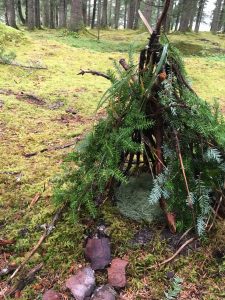 Juneau Community Charter School (JCCS) does a great job of incorporating place-based education into the classroom. In the first week of school, we took students or on a walk through downtown to get them oriented in where we are. The second week of school, we went to Echo Ranch for three days of camping. Students could choose classes like: canoeing, making campfires and cooking on them, knot tying (for boating), trail running, and various other outdoor Alaskan skills. The students’ favorite activity was building “gnome houses” (photo left) out of only natural materials that they found in the forest. About every other week students take either a walking field trip, or go on a hike in gym. One of the most popular exploratory classes is photography, where students have been documenting downtown Juneau through photographs. Another popular exploratory class is working with a naturalist from Discovery Southeast to take field notes on various hikes throughout Juneau.
Juneau Community Charter School (JCCS) does a great job of incorporating place-based education into the classroom. In the first week of school, we took students or on a walk through downtown to get them oriented in where we are. The second week of school, we went to Echo Ranch for three days of camping. Students could choose classes like: canoeing, making campfires and cooking on them, knot tying (for boating), trail running, and various other outdoor Alaskan skills. The students’ favorite activity was building “gnome houses” (photo left) out of only natural materials that they found in the forest. About every other week students take either a walking field trip, or go on a hike in gym. One of the most popular exploratory classes is photography, where students have been documenting downtown Juneau through photographs. Another popular exploratory class is working with a naturalist from Discovery Southeast to take field notes on various hikes throughout Juneau.
Another way that JCCS incorporates place-based learning is through the community service focus. JCCS has three different community service courses broken up by grade. The 6th graders plan a menu and prepare a meal for the Glory Hole once a month and use class time to prepare, which means getting donations from families and local businesses. The 7th graders volunteer to help in lower grades in the fall and in the spring they volunteer at Discovery Preschool. The 8th graders design their own community service project that includes working with a mentor for the year.
As far as culturally-responsive teaching, I see some gaps within the curriculum. In Social Studies and Language Arts we have been working on a lesson on reading portraits as biographies, we examined portraits of many diverse historical figures as well as portraits of “regular” people from around the world. I liked the way students had a chance to look at art created by and depicting people from all different cultures. We also have book groups and mine is currently reading “The Absolutely True Diary of a Part-Time Indian” by Sherman Alexie. However, in a curriculum that is so project-based and where students get a lot of choice in their learning, many of them do not “choose” to learn about other cultures. I see an many opportunities to incorporate studies specifically on Tlingit culture and the active Tlingit community here in Juneau. When I begin my Social Studies unit on the Civil Rights Movement I plan to show the film Jerry was in about Elizabeth Peratrovich and hopefully invite some guest speakers in to class to speak more about social justice issues here in Juneau. I would also like to take students on trip to the Alaska State Museum and to the Sealaska Heritage Center during our unit on developing biographies of historical figures. I’m also really looking forward to the exploratory class that will take place in the spring with Abel Ryan who is a Tsimshian carver and metal worker. Again though, if students do not choose the certain book group or exploratory class, they could miss various opportunities for more culturally-responsive lessons. I hope to incorporate more culturally-responsive lessons into classes that everyone will take.


